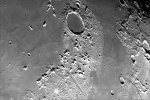Hitchhiker's Guide to Rukl Chart 3
 Thierry Legault's
CCD image of Plato (bottom right), the Alps (top left) and Mons Piton
(top right) at the edge of Mare Imbrium.
Thierry Legault's
CCD image of Plato (bottom right), the Alps (top left) and Mons Piton
(top right) at the edge of Mare Imbrium.
See also an impressive
high-resolution shot
of the Triesnecker area at
astro-shop.com,
and Robin
Casady's image of Plato and the nearby mountains, on
chart 11.
- Plato (JRF <freeman _at_ netcom.com>)
-
This dark-floored walled plain is prominent under most sun angles.
Plato is a "landmark" feature, easily recognized and useful for
orientation. The four or five largest interior craterlets -- all
shown in Rukl -- are an interesting test of a telescope's ability to
see lunar detail. I have seen two in a 90 mm fluorite refractor, at
202x.
- Plato (Thomas Back <am678 _at_ cleveland.Freenet.Edu>)
-
On the night of Tuesday, April 15, about 11:00pm, I had a wonderful
view of the Moon. Seeing was 8+ (on a scale of 1 to 10), and the Moon
was very high in the sky. My Astro-Physics 180mm f/9 EDT was fully
cooled down, and at 405x (Zeiss 4mm ortho -- no filter), the image was
breathtaking. The whole region around Plato and the Alpine Valley was
closely scrutinized. I often look for the .25 arc-second rill in the middle
of the Alpine Valley, but this night was something else. The entire length of
the rill was seen without difficulty, and because of the sun angle, had a
very thin white apperence to it. But the real surprise was Plato. Under the
best conditions, I've confirmed 9 craterlets inside the crater. That night,
because of the shallow sun angle, most of Plato was in shadow. However,
the twin craterlets (the most obvious ones) were visible. What I saw next
was almost 3-D. I could see the outside base of the craterlets rising up to
the craters rims! I'm not talking about the inside of the craters, but the
slope outside the crater. I've never seen anything like it before, and the
conditions, I'm sure, were perfect for this type of observation.
- Plato (David W. Knisely <dk84538 _at_ navix.net>)
-
I have seen that low-sun-angle effect on the ramparts of
small craters. In fact, when I first observed the crater Linne with an
8", I though it was a small hill instead of a crater! However, once the
sun get higher, the effect fades away. I cheat a little when it comes to
viewing Plato's craterlets, however. I observe them during the full moon
when they all look like little white dots and are very easy to see!
- Plato and Fontenelle (Akkana)
![[Plato and Fontenelle]](../images/sketch/fontenelleT.jpg)
-
July 13, 1997: Rimae Plato was fairly obvious, but I could see no trace
of Rima Archytas in either the 6" Cave or a C-8 in the somewhat unsteady
seeing. Another rille (or similar linear feature) runs perpendicular to
R. Plato; the feature is not well shown on Rukl chart 3, but could be the
feature labelled just "Plato" (aside from the crater itself).
- Plato (David North <d _at_ timocharis.com>)
-
One of the things that struck me was how easy it is to see the craters
in Plato just at sunrise. They have the light halo and deep dark that
craters get just as the sun hits them, with that slightly puckered
illusion. Even the "tight double" was easy pickings in that light.
- Plato (ALPO)
-
There is also an
ALPO
Selected Areas Program page on Plato.
This page last modified: Dec 06, 2020
All materials on the Hitchhiker's Guide to the Moon are ©
Copyright the individual authors.
The Hitchhiker's Guide to the Moon Compilation is
© Copyright 1999,2000,2002 Akkana Peck.
Hitchhiker's Guide to the Moon |
Search the Hitchhiker's Guide |
Shallow Sky Home |
comments or contributions
![[Plato and Fontenelle]](../images/sketch/fontenelleT.jpg)
 Thierry Legault's
CCD image of Plato (bottom right), the Alps (top left) and Mons Piton
(top right) at the edge of Mare Imbrium.
Thierry Legault's
CCD image of Plato (bottom right), the Alps (top left) and Mons Piton
(top right) at the edge of Mare Imbrium.
![[Plato and Fontenelle]](../images/sketch/fontenelleT.jpg)